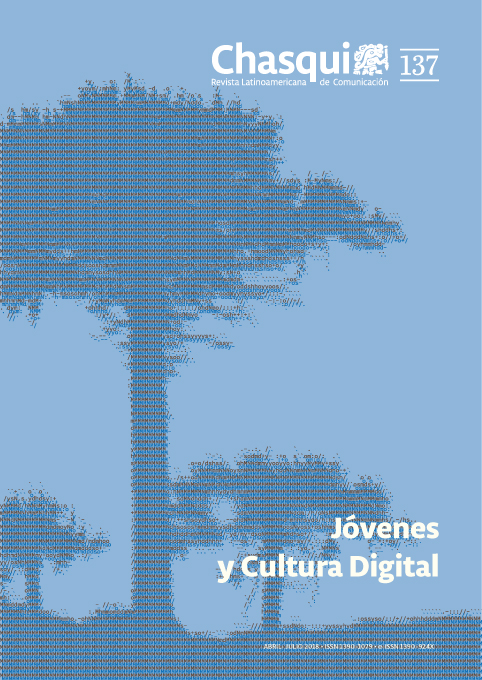Nomadization, digital citizenship and autonomy. Youth trends at the beginning of the 21st century
DOI:
https://doi.org/10.16921/chasqui.v0i137.3381Keywords:
youth, technologies, trends, digital cultureAbstract
This article explores some of the juvenile tendencies observed among the generation of young contemporaries. The objective is to provide useful categories and reflections to continue investigating problems associated with young generations and ICT. Among the results, three trends stand out. In the first place, the nomadization of audiovisual and ludic consumption, in relation to the growing youthful practice of consuming ubiquitously and, to a lesser extent, producing audiovisual content. Second, digital citizenship, which refers to the centrality of these technologies in youth identity. Finally, the autonomy and independence to entertain, inform and relate of the young generations with respect to institutions traditionally managed by adults, and the conflicts and possibilities that this arouses.References
Albarello, F. (2011). Leer y escribir en Internet. Buenos Aires: La Crujía.
Atal, M. (2007). Coming of Age in Cyberspace. New York Times, 24 de septiembre de 2007.
Baricco, A. (2008). Los bárbaros. Ensayo sobre la mutación. Barcelona: Anagrama.
Bauman, Z. (2013). La cultura en el mundo de la modernidad líquida. Buenos Aires: Fondo de cultura económica.
Beck, U. & Beck-Gernsheim, E. (2003). La individualización: el individualismo institucionalizado y sus consecuencias sociales y políticas. Barcelona: Paidós.
Benítez Larghi, S. (2013). Lo popular a partir de la apropiación de las TIC. Tensiones entre representaciones hegemónicas y prácticas. Question, 38(1), s/n.
Bennahum, D. (1999). Extra Life: Coming of Age in Cyberspace. New York: Basic Books.
Boczkowski, P. y Mitchelstein, E. (2017), “Smartphone, el aire que respiro”, en Anfibia, http://www.revistaanfibia.com/ensayo/smartphone-aire-respiro/
Boltanski, L. & Chiappelo, E. (2002). El nuevo espíritu del capitalismo. Madrid: Akal.
Boyd, D. (2014). It's Complicated: The Social Lives of Networked Teens. New Haven: Yale University Press.
Buckingham, D. (2013). Beyond Technology: Children's Learning in the Age of Digital Culture. New York: Wiley.
Castells, M. (2009). Communication Power. New York: Oxford University Press.
Dipaola, E. (2017). Lazo social y globalización: las sociedades imaginales y un abordaje metodológico para su estudio. Athenea Digital, 17(1), 249-267.
Felice, M. (2017). La "casa de la amistad": modos de construir y significar el hogar propio en jóvenes de la Ciudad de Buenos Aires. Última Década, 25, 117-146.
López, G. y Ciuffoli, C. (2012). Facebook es el mensaje. Oralidad, escritura y después. Buenos Aires: La Crujía.
Elizalde, S. (2015). Nuevas y viejas formas del (des)encuentro amoroso. En Quevedo, L. (comp.), La cultura argentina hoy. Tendencias (pp. 375-400). Buenos Aires: Siglo XXI.
Feixa, C. (2014). De la generación @ a la #Generación. La juventud en la era digital. Barcelona: Ned.
Howe, N. & Strauss, W. (2000). Millenials Rising: the Next Great Generation. New York: Vintage.
Igarza, R. (2010). Burbujas de ocio. Nuevas formas de consumo cultural. Buenos Aires: La Crujía.
Illouz, E. (2007). Intimidades congeladas. Las emociones en el capitalismo. Buenos Aires: Katz.
Aires: La Crujía.
Downloads
Published
Issue
Section
License
- Authors retain copyright and grant the journal right of first publication with the work simultaneously licensed under a Creative Commons Attribution-NoDerivs License (CC BY-ND) that allows others to share the work with an acknowledgement of the work's authorship and initial publication in this journal.
- Authors are able to enter into separate, additional contractual arrangements for the non-exclusive distribution of the journal's published version of the work (e.g., post it to an institutional repository or publish it in a book), with an acknowledgement of its initial publication in this journal.
- Authors are permitted and encouraged to post their work online.

